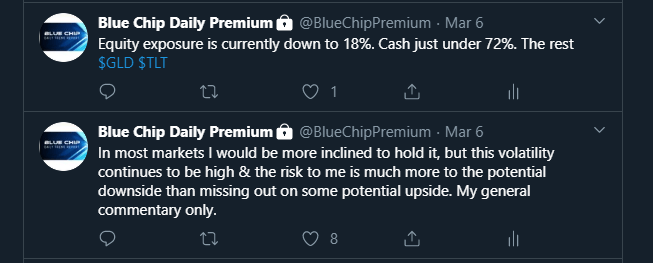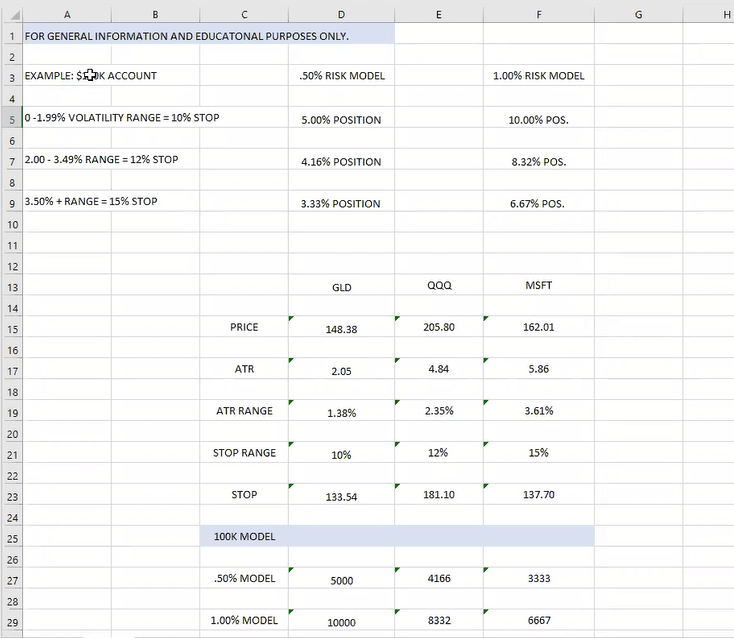In this blog and video, I will discuss two core risk management strategies that have helped me reduce drawdowns and minimize losses. The S&P 500 just went through a 26% drawdown in 16 trading sessions, 3393 on 2/19 to 2478 on 3/13. There could be more downside, or not, this is not a market analysis blog.
I am reading online about private traders and large hedge funds that have not been positioned correctly and have seen steep recent losses. There is much more to professional trading and investing than making random market calls daily, or drawing a few predictive trendlines and arrows on a chart hoping to get it right. Markets go where they go, and as we have seen, can be very volatile. What traders do when they get it wrong is what keeps them in the game over decades. I have been trading since 1998, and although my time frame is geared towards intermediate to longer-term position traders and investors, the basic concepts apply across all time frames.
We focus on reactive price analysis, trend identification and exact risk management & position sizing.
Following are three major risk management strategies that I incorporate all day, every day.
Basic Risk Management concepts that I follow daily:
1) know exactly where the risk is on the downside before I take a position, and use hard stops, GTC, to define and limit position risk (stop losses)
2) know exactly how much I am prepared to lose on any trade if it goes against me (position sizing)
3) monitor open risk in the account, so that if ALL positions get stopped out, the loss is within pre-defined limits (portfolio level risk sizing)
We have been fortunate to have been positioned very defensively, and avoided the majority of this drawdown, as we have been building cash since 2/25, as outlined on our premium Twitter feed.




STOP LOSSES:
The way that I learned risk-management is to know exactly where I am getting out on the downside if the position goes against me, before I get in. When I get a trade entry signal, the first thing I do is identify the downside stop loss exit, and base my position size on this. My stops are volatility based in to a fixed percentage. For this Blog, I am going to use a very basic 10% stop, for ease of math only. My stop ranges can be wider or more narrow based on trade signal, time frame and volatility.
I use GTC hard stops. This means when I get filled on a position, as soon as the order is filled, the hard stop, GTC, goes into the system. I trade highly liquid, large caps, mega caps and high volume ETFs. If I take a position with a 10% stop, if the position goes against me by 10%, then I was wrong, my stop order is executed and the position is closed out automatically in the platform.
$AAPL CHART EXAMPLE:
$305 ENTRY, 10% STOP, HARD STOP JUST UNDER $274.50

I don’t use closing price stops. If I take a position at $100 and the stop is a break below $90, as soon as that hits, I am out. If my risk is defined at $90, why would I wait until the close when the stock could be much lower? If the stop is a break under 90, when it hits, it hits.
I don’t use mental stops. Paul Tudor Jones spoke about this in Market Wizards in 1989 when he was the largest player in the S&P futures pit. None of us is Paul Tudor Jones, and these are highly liquid markets with much tighter spreads than 1989. A mental stop is another way to say no stop or no process.
Exceptions: In a rare instance of a general market gap down through stops, I may remove the stop briefly in one or two core longer term names, but this is based on market experience, and I have the discipline to put the stop right back in after the gap down. For someone who doesn’t have the market experience or discipline to do this, the hard stop works best. This scenario may happen a few times a year at best, if any, and only in one or two names. If I am holding 5 names that gap past my stops, I may pull a stop in one or two for a few minutes, the rest will get stopped out on the gap.
In summary, I define risk and stop levels at entry, and use hard stops, GTC in the system, not closing stops or mental stops.
POSITION SIZING
This may be the most important aspect of trading that professional traders and investors focus on constantly, and that novice traders have very little knowledge about, and some who do, don’t use it. It is correct position sizing. The concept is when a trader says they are “risking 1%”, it does not mean they are putting 1% of assets into a position, it means if they get stopped out, the loss will be 1% of equity.
Here is a general example:
$100K account
$AAPL with a 10% stop
Position size = $10,000
Stop = 10%
Stop $ = $1000 ($10,000 x .10%)
Loss if stopped out = $1,000
Equity hit: $1,000 loss vs $100K account = 1% loss.
The above math is a general example. To back into the math, a trader first determines what their overall account risk position sizing is, then their stop loss range, from here the position size is determined.
This leads to a much more detailed discussion on sizing, position management and risk management, and is a topic that I focus on daily, and in educational videos and blogs for our website members. From our 2/25 Members video:

$GDX EXAMPLE ONLY (NO POSITION)
In the above example, which I did not have a position in, even though $GDX went down by 14% in one day, a trader with correct stops and risk sizing capped their risk at a 1% loss vs equity, would be closed out at 25.65, and avoid the drop to 16.50 A very mild vs the overall drawdown.
SUMMARY:
The bottom line key takeaway, is that to trade or invest professionally, and make it through decades of various market conditions, traders and investors must focus on professional risk management and money management strategies as the core component of their plan, which go well beyond the context of making daily market calls, trying to guess what’s next or drawing trendlines and arrows on a chart. Learn and master the math of risk management, position management and money management.
